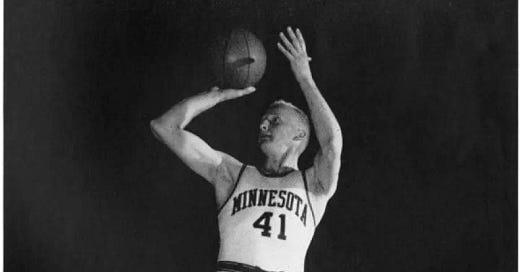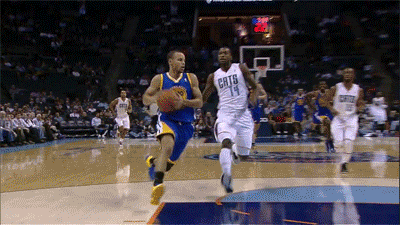Don’t Leave Your Feet
Walk into any given basketball practice and you may hear a coach yelling “Don’t leave your feet!” to one of their taller players. You see, us small guys try all sorts of things to gain an advantage, and one of our favorite tools is the shot fake.
If I can keep moving while my defender has left the ground, I now have free reign to move into open space. And open space can mean an easier shot.
However, there was a time where the refrain, “Don’t leave your feet.” was meant for more than just defenders that were getting beat by their opponents. There was a time when most coaches believed jumping to SHOOT was reckless, dangerous, and downright immoral.
Leaving one’s feet to shoot meant that one was no longer in complete control, didn’t have proper balance, and that a player was selfishly relying on their own abilities rather than the help of their teammates to set good screens and get them open.
Ski Jumping and Basketball
So what do ski jumping and basketball have in common? The answer: Norwegian American legend Myer “Whitey” Skoog. Whitey was the son of Norwegian immigrants, and grew up in rural Minnesota during the 1940s.
When Whitey’s father immigrated from Norway he brought a love of ski jumping alongside him. As a young boy, Whitey and his brothers went with their dad to Boom Lake and learned to catapult off the ski jump there. From the moment Whitey first learned to ski jump, the instinct to jump was engrained in his psyche.
In junior high, Whitey’s basketball coach told him, “Except for rebounding, in basketball you keep your feet on the floor.” Whitey tried with all his effort to stay on the floor, but eventually his instincts got the best of him.
Several years later, in a critical high school game between Whitey’s Brainerd Minnesota Warriors and rival opponent Bemidji, Whitey did the unthinkable. In order to break free from his star opponent, 6’ 5” Phil Feir (Whitey was 5’ 11”), Whitey JUMPED. His first jump shot fell short of the basket, but that wasn’t enough to cage his instincts.
With the game coming to a close and his team losing 31-30, Whitey jumped and dropped a 25-foot shot into the basket to give his team the victory 32-30. The jump shot had arrive for Whitey and it stayed with him over the course of an amazing college career for the Minnesota Gophers and during time as a professional with the Minneapolis Lakers.
Jump Physics
One of the most intriguing parts of Whitey’s story is not that he started taking jump shots when NO ONE was taking jump shots, but HOW he jumped. As you can see in the image above, he would kick his legs up behind him when jumping. That doesn’t seem consistent with ski jumping to me, but it made me wonder what would have motivated the leg-raising leap.
In the world of physics there is something called the impulse-momentum theorem. The impulse-momentum theorem states that the change in an object’s momentum is equal to the amount of force applied over a period of time to the object. The equation looks as such:
Where F= Force, t= time, and p = momentum.
For jumping this is applicable because you are trying to change your momentum during your approach. As you run through your approach, you increase your speed (velocity) so that you are at max velocity at toe-off (when your body is leaving the ground).
The above equation can also be written as follows:
Where m = mass, vf= final velocity, and vi = initial velocity.
Solving the equation for F, shows us something interesting.
In this equation as we DECREASE the amount of time, the amount of force INCREASES.
In theory, the quicker we get off the ground when jumping, the more force we will be applying and the faster we will come off the ground. I wonder if this was what Whitey was instinctively trying to do when he shot his legs up behind him, get off the ground quickly and get above his opponent.
In practice there seem to be limits/unintended consequences of trying to get off the ground really quickly. It can create awkward rhythm and coordination, and it may be that your nervous system can’t fire quickly enough to generate peak force.
Either way, jumping like Air Skoog is worth a try or two.
Training Update
I wish I could post more videos of my training and dunking but alas, I am still trying to resolve some technical difficulties with my phone and computer. What I will say is: 1. I AM jumping high enough to keep dunking off of lobs, 2. I don’t have someone to lob the ball to me training so I have been practicing self lobs, and 3. Those self-lobs are off the mark about 95% of the time. I have a feeling I have many more failed self-lobs to go before I get it down.
This is a good point to update you on my newest dunk goals! If you though I would retire after one dunk, you are WRONG! In the words of that 90s (or was it early 2000s?) game show, “You are the weakest link, goodbye.”
My first goal is as outlined above:
1-Hand dunk off self-lob
My second goal is as follows:
2-Hand dunk off lob
I am jumping high enough to touch the rim with both hands, but with my left shoulder continuing to hurt I haven’t attempted a two-hand dunk yet. However, I just started working with a “shoulder guy”, Chris Williams of Archery Strong, and our first call today made me confident that he is the guy that will help my shoulder go from zero to hero!
Let’s get that self-lob and two-handed dunk! Dunk Camp 2025, I am coming for you with a vengeance! Happy jumping everyone!









